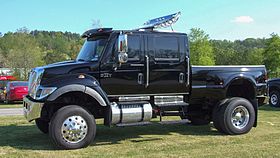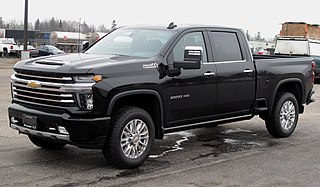
The Chevrolet Silverado is a range of trucks manufactured by General Motors under the Chevrolet brand. Introduced for the 1999 model year, the Silverado is the successor to the long-running Chevrolet C/K model line. Taking its name from the top trim level from the Chevrolet C/K series, the Silverado is offered as a series of full-size pickup trucks, chassis cab trucks, and medium-duty trucks. The fourth generation of the model line was introduced for the 2019 model year.
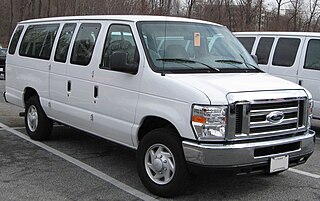
The Ford E-Series is a range of full-size vans manufactured and marketed by the Ford Motor Company. Introduced for 1961 as the replacement of the Ford F-Series panel van, four generations of the model line have been produced. Marketed for both cargo and passenger transport configurations, the E-Series has been designed with multiple design variations for both retail and commercial sale, including vans, and commercial-grade cutaway van chassis and stripped chassis.

The Ford F-Series is a series of light-duty trucks marketed and manufactured by Ford Motor Company since the 1948 model year. The F-Series is marketed as a range of full-sized pickup trucks positioned above the midsize Ranger but below the larger Super Duty in the Ford truck lineup. Alongside the F-150, the F-Series also includes the Super Duty series, which includes the heavier-duty F-250 through F-450 pickups, F-450/F-550 chassis cabs, and F-600/F-650/F-750 Class 6–8 commercial trucks.

The Ford Excursion is a heavy-duty SUV marketed by Ford Motor Company from 2000 through 2005. At its introduction, the Excursion was the longest and heaviest SUV ever to enter mass production. The third Ford SUV was derived from the F-Series pickup trucks, and the model line used a heavier-duty chassis and frame than the Expedition; both vehicles competed against the Chevrolet Suburban.
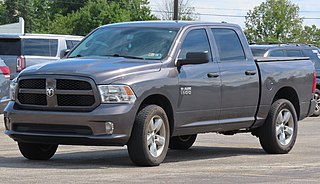
The Ram pickup is a full-size pickup truck manufactured by Stellantis North America and marketed from 2010 onwards under the Ram Trucks brand. The current fifth-generation Ram debuted at the 2018 North American International Auto Show in Detroit, Michigan, in January of that year.

The Navistar VT engine family is a line of diesel engines that was produced by International Truck and Engine from 2003 to 2016. Developed as the replacement for the T444E V8, the VT V6 and V8 diesels were the smallest diesel engines used in Navistar vehicles, slotted below the DT inline-6 engine family. Sharing many applications with the DT466 inline-6, the VT engines were used in medium-duty trucks and school bus chassis, competing against the Cummins B-series and the Mercedes-Benz MBE900 diesel engines. In 2007, both the VT and DT engines were rebranded under the MaxxForce brand name, with model designations related to their displacement.

The Ford Super Duty is a series of heavy-duty pickup trucks produced by the Ford Motor Company since the 1999 model year. Slotted above the consumer-oriented Ford F-150, the Super Duty trucks are an expansion of the Ford F-Series range, from F-250 to the F-600. The F-250 through F-450 are offered as pickup trucks, while the F-350 through F-600 are offered as chassis cabs.

The Chevrolet Kodiak and GMC TopKick are a range of medium-duty trucks that were produced by the Chevrolet and GMC divisions of General Motors from 1980 to 2009. Introduced as a variant of the medium-duty C/K truck line, three generations were produced. Slotted between the C/K trucks and the GMC Brigadier Class 8 conventional, the Kodiak/TopKick were developed as a basis for vocationally oriented trucks, including cargo haulers, dump trucks, and similar vehicles; on later generations, both cutaway and cowled-chassis variants were produced for bus use.

The International DuraStar line, known as the 4000 series prior to 2008 and the DuraStar Series from 2008 to 2018, is a line of medium-duty trucks produced by Navistar International since 2001. Introduced as the successor to the International 4000 series of 1989–2001, the 4000 series was renamed the DuraStar in 2008. Developed as a Class 6-7 product range, the 4000/DuraStar was slotted below the 8000/TranStar regional-haul semitractor, with the Class 5 International TerraStar (2010–2015) serving as the smallest International conventional-cab product range.

The International S series is a range of trucks that was manufactured by International Harvester from 1977 to 2001. Introduced to consolidate the medium-duty IHC Loadstar and heavy-duty IHC Fleetstar into a single product range, the S series was slotted below the Transtar and Paystar Class 8 conventionals.

The International TerraStar is a medium-duty truck that was manufactured by International Trucks from 2010 to 2015. The smallest conventional-cab truck ever produced by International, the TerraStar competed against chassis-cab vehicles derived from large pickup trucks along with the smallest versions of the Freightliner M2 and Hino 600. Though never officially designated by the company as a replacement for the 2006-2009 CityStar LCF COE, the TerraStar is of similar dimensions and GVWR.

The International WorkStar is a line of severe duty trucks produced by Navistar, Inc. The WorkStar is the successor to the 7400 and 7600 series trucks produced by International. Starting in 2008 the "thousand series" name was dropped in favor of the WorkStar. This change was reflected in the physical construction of the truck in the form of a new hood and grill along with increased MaxxForce Engine options.

The sixth generation of the Ford F-Series, also known as the "dentside Ford" to enthusiasts, is a line of pickup trucks and medium-duty commercial trucks that were produced by Ford Motor Company from the 1973 to 1979 model years. Produced by Ford in North America, Argentina, and Australia, this is the third and final generation of trucks derived from the 1965 Ford F-Series.

The eighth generation of the Ford F-Series is a line of pickup trucks and light- to medium-duty commercial trucks produced by Ford from 1987 to 1991. While the previous generation cab and chassis were carried over with minor changes to the vent windows, interior trim mounting locations, and floor pan shape on the transmission hump, the 1987 model was more streamlined, and maintenance items were made simpler. The exterior was facelifted with new composite headlamps – the first American truck to have them – as part of a more aerodynamic front end. Inside, the interior was given a complete redesign. Rear antilock brakes were now standard, the first pickup truck to boast this. For the first time, all models were produced with straight-sided Styleside beds; the Flareside bed was discontinued except for a small number of early 1987 models using leftover 1986 beds with new circular fenders. In October 1989, the taillights' white reverse light was decreased in size.

The ninth generation of the Ford F-Series is a lineup of trucks that were produced by Ford from the 1992 to 1998 model years. The final generation of the F-Series to include a complete range of trucks from a half-ton F-150 pickup truck to a medium-duty F-800 commercial truck, this is the third generation of the F-Series body and chassis introduced for 1980.

The eleventh generation of the Ford F-Series, marketed as the Ford Lobo in Mexico, is the company's line of light-duty pickup trucks manufactured and marketed by Ford for the 2004 to 2008 model years. With a redesigned body and chassis, and marketed as its F-150 line, between the company's Ranger and the Super Duty trucks.
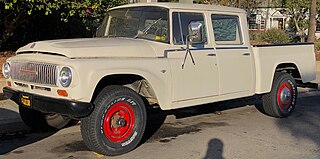
The Travelette is a sub-model of International Harvester's series of light-duty pickup trucks that was produced from 1957 to 1975. The Travelette was the first factory-production, 6-passenger, crew-cab pickup truck, made by any United States manufacturer.
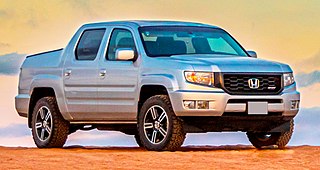
The Honda Ridgeline (YK1) is the first generation of pickup truck manufactured by Honda for North America. According to some automotive journalists, the first generation Ridgeline has some noteworthy designs, including:

The fourth generation of the C/K series is a range of trucks that was manufactured by General Motors. Marketed by the Chevrolet and GMC brands from the 1988 to the 2002 model years, this is the final generation of the C/K model line. In a branding change, GMC adopted the GMC Sierra nameplate for all its full-size pickup trucks, leaving the C/K nomenclature exclusive to Chevrolet.

The first generation of the Chevrolet Silverado is a series of trucks manufactured by General Motors from 1998 until 2007 under the Chevrolet brand and also as the GMC Sierra. Built on the new GMT800 platform, the Silverado/Sierra 1500 and 2500 pickup trucks were first released in August 1998 as 1999 models. The "classic" light-duty GMT400 C/K trucks were kept in production alongside the new types for the first model year, while the heavy-duty GMT400 pickups were continued until 2000, with the new GMT800 Silverado/Sierra HD released in model year 2001. A 3500 model was added later for 2001, with the introduction of the HD moniker. A refresh for 2003 models was introduced in 2002, bringing slight design changes and an upgrade to the audio and HVAC controls. The 2007 GMT800 trucks, built after the new GMT900 had gone on sale, used the name Classic to denote the difference between the two generations.
